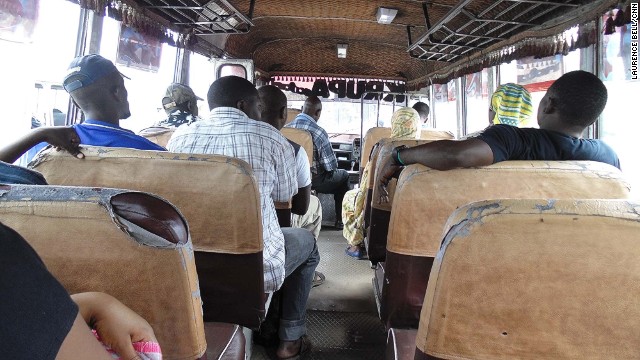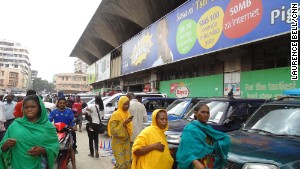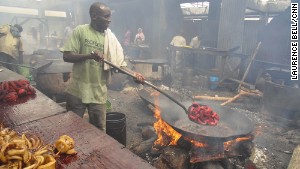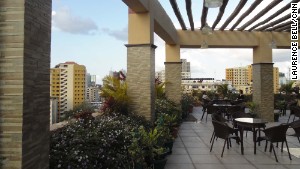Fruit for thought in Tanzania nutrition fight |
||
|
|
||
The government is waging an uphill struggle against malnutrition, urging residents to eat more fruit.
Chika Oduah
Last Modified: 29 Oct 2013 10:08
|
||

Tanzania faces the strange contradiction of high food production and high malnutrition [Chika Oduah/Al Jazeera]
|
||
|
Selemani Hussaini never thought much about eating fruit in the past. The 46-year-old Tanzanian farmer mainly eats ugali, a thick maize-based porridge. Toss in a few cooked beans, tea or instant coffee and this completes a typical meal. "This is how we are raised to eat," says Hussaini. "No one really talked about fruit." Hussaini lives in Tanzania’s second-largest region, Morogoro. He is part of the nearly 75 percent of the national population living in rural areas. Here, long-held food customs often neglect the value of fresh fruit consumption and local attitudes show evidence of a widespread lack of awareness on basic nutritional information. "Due to traditional reasons, fruits were never considered as part of the main meal," says nutrition specialist Alex Nalitolela, He sees first hand how local perceptions about food have largely contributed to high levels of malnutrition. The chronic malnutrition has lead to a 42 percent stunting rate for children under five in a country of roughly 44 million people. Low-caloric diets and an insufficient intake of vitamins have prevented millions of children from ever reaching their normal height and weight levels. Nalitolela works with Mwanzo Bora, a five-year regional nutrition project led by Africare and supported by the USAID’s Feed The Future initiative. The project, launched in 2011, addresses malnutrition by integrating nutrition and agricultural strategies. One of those strategies involves setting up Farmer Field Schools and demonstration garden plots to teach local communities about diet diversification and conduct trainings on home gardening to grow fruits and vegetables. "Our aim is to make sure community members get a diverse food diet in their homes," Nalitolela says. Mwanzo Bora has established 20 demonstration plots throughout the regions where it operates: Dodoma, Morogoro, Manyara and Zanzibar. A major part of Mwanzo Bora’s strategy is changing local ideas and behaviours surrounding food. The project organizes peer support groups for neighbors to help each other incorporate the changes they are learning through Mwanzo Bora. So far, more than 6,000 people have been mobilised into these networks to support pro-nutrition behaviors, according to the latest report. Local farmers participating in Mwanzo Bora had to learn to keep some of the fruits and vegetables from their new gardens for home consumption rather than completely selling them at the local market. Many of them, like Daria Amre, have adapted to this change by maintaining a larger farm to harvest produce for sale alongside a smaller home garden to keep the goods for the household. Behind her mud brick home on the fertile slopes of the Uluguru Mountains, Amre grows lettuce, cabbage, spinach, leeks, potatoes and she eats the ripe fruits, such as jackfruit, from nearby trees. She says her three children, whose ages range from almost two to ten years old, do not experience as many illnesses since she incorporated the practical nutritional knowledge she has learned from Mwanzo Bora. Promoting nutrition
"You can find a large contradiction," says Obey Assery, a director in the office of the Prime Minister. "We have high food production and high malnutrition." Assery is a spokesperson for the government’s nationwide agenda to address malnutrition. "It’s more about social behavior change. That is our strategy," he explains, noting that local communities do not lack food, but lack knowledge. The efforts are part of a robust national campaign, involving nine ministries, to integrate nutrition and prioritise economic development through agriculture. Agriculture accounts for more than 25 percent of the gross domestic product and the sector employs nearly 75 percent of the work force. The government implemented two landmark initiatives, Kilimo Kwanza and the Southern Agricultural Growth Corridor of Tanzania Centre (SAGCOT), to foster agricultural commercialisation and malnutrition reduction. Since its implementation in 2008, Kilimo Kwanza, which means "agriculture first" in Kiswahili, has paved the way for private sector investors to work with small-scale farmers on securing agriculture productivity and boosting profit yields. The 2011 SAGCOT strategy concentrates and evaluates development in the country’s food-producing regions. A parliamentary group solely dedicated to nutrition advocacy is pushing policies to ensure cross-sector participation. For example, in May the government rolled out a food fortification program partially funded by the UK-government to mandate local food processing factories to comply with maize flour fortification regulations. The aim is to reduce micronutrient deficiencies. Community-based engagement But beyond the policies and government initiatives, nutritionists like Nalitolela say it comes down to the grassroots level-- teaching farmers, mothers, fathers and children how to eat right and change local perceptions about food, particularly fruit.
"So far, urban residents seem to be more positive to accept the role of fruits on human health than rural people do," he says. He continues to recommend eating an orange a day, a mango a day, or even just a slice of papaya regularly. His recommendations are working for Hussaini, who admits that his eating habits have changed since engaging with Mwanzo Bora. "I was not use to eating the fruits and vegetables but now I must eat it everyday," he says. On his one-hectare farm, he not only grows the staple, maize, but he also produces carrots. He says now his favorite fruits are avocado, banana and passion fruit. He points to his son and says he and wife are teaching their five children to enjoy eating fruits. Follow Chika Oduah her on twitter @chikaoduah |
||
|
Source:
Al Jazeera
|
||
 |
The blog is intended to provide the readers daily news on Tanzania politics,Tourism, education , Business, health, culture, sports, artwork, family/friend affairs, travel, social welfare, community dev, general knowledge and life ventures. Welcome
Wednesday, 30 October 2013
Fruit for thought in Tanzania nutrition fight
Sunday, 27 October 2013
Dar es Salaam by 'magic bus': Bumpy but brilliant
By Laurence Bell, for CNN
October 25, 2013
 A dala dala is a bus ("dala dala"
for "dollar," which used to be the standard fare) in Dar es Salaam. The
interiors aren't exactly sumptuous. But for getting around Tanzania's
biggest city they're a local favorite -- cheap, practical, everywhere.
A dala dala is a bus ("dala dala"
for "dollar," which used to be the standard fare) in Dar es Salaam. The
interiors aren't exactly sumptuous. But for getting around Tanzania's
biggest city they're a local favorite -- cheap, practical, everywhere.
4
5
6
7
8
9
>
>>
STORY HIGHLIGHTS
- Dala dala get their name from the "dollar" that a journey cost in the 1970s
- They're a local way to get around the city's districts and destinations
- They can be uncomfortable, but they're always fun and riders are friendly
We move off, clattering along the noisy, dusty road.
The city is Dar es Salaam, Tanzania's biggest and the place President Obama hung out on his July visit to East Africa.
The man is the conductor
and his bus is a "dala dala" -- hordes of which toot and rattle along
the key arteries through Dar es Salaam every day.
This city is often ignored by travelers heading to Tanzania's big tourist destinations -- it's not hard to see why.
"Dar" has few obvious attractions and can get hot and sticky.
Its streets are filled with traffic, exhaust fumes and dust.
Yet it has charm and for
anyone willing to experience some "Bongo flava" via one of these
eccentric buses, the rewards can be great. ("Bongo flava" is the
Tanzanian brand of R&B/hip hop, which originates here in Bongo Town,
the local nickname for Dar).
Dala for dollar
Dala dala get their name
from the slang term for five Tanzanian shillings ("dala" for dollar),
the bus fare in the 1970s and 1980s when these vehicles started
operating as a response to poor public transportation.
Now a standard trip costs 400 shillings (25 cents), though the fare can be more if you're going a long distance.
Dala dalas are an
attraction in and of themselves, their bright exteriors painted in set
designs and colors that indicate the route.
Dala dalas are featured
in one of the most popular Tanzanian TV shows, with random people being
picked up to discuss issues of the day as they get a ride to work.
I spend a day exploring
the city via dala dala, invariably slotted into a sweaty squeeze,
forehead dangerously close to the metal frame hanging from the roof.
Yet however crowded it gets inside, the atmosphere is friendly.
When I ask where to get
off for Kariakoo market, a fellow passenger offers to escort me there.
He turns out to be a fisherman on a day off.
Conversation along the
way ranges from Tanzania's chances in the football World Cup qualifier
against Ivory Coast to the best fishing and diving spots.
Kariakoo market variety
Kariakoo market, the largest market in East Africa, is worth the stop.

East Africa's biggest market.
It covers several blocks of shops, stalls and courtyards all set around an imposing indoor market built in the 1970s.
Its high vaulted arches provide an odd setting for the small hardware sellers who inhabit it.
Downstairs there's a huge basement complex where fruit and vegetable traders dwell in semi-darkness.
Above ground Kariakoo is full of color and trade in a huge variety of goods, from farming tools and food to bows and arrows.
It's a good spot for
sampling Dar's abundant street food -- a combined product of the fertile
Tanzanian soil and Indian influences.
Options include chipsi
mayai (chips/fries in an omelet -- a Tanzanian staple), samosas,
chapattis, roasted corn served with chili and lime, mandazi (something
like a doughnut), sugarcane and tropical fruits.
Drinks include coconut juice straight from the coconut or coffee from one of Dar's renowned mobile street coffee vendors.
Dar is a port city, so also a place for seafood.
For this it's best to go to source.
Fried octopus snacks

One of many snacks on offer -- fried octopus.
A short dala dala ride
from Kariakoo, the main fish market assaults the senses; it's full of
activity, shouts, smells and a variety of fish and sea creatures.
At one end the market, a
concrete wall drops down to the natural harbor where fishing boats sit
on the white sands or at anchor in the water.
At the other end, their haul is cooked up in huge sizzling frying pans.
Still chewing some deep-red fried octopus, I board a dala dala moving along the seafront.
Although color-coding
makes them they look like a single organized collective, dala dalas are
private enterprises and feature a range of individual touches
representing the owners' tastes and allegiances.
The most obvious of
these are slogans many carry on the windshield sunshade, ranging from
religious ("Allah Akbar," "Jesus Power") to sporting ("Liverpool
Forever") to cryptic ("New Passion," "Simba Family").
In this sense they're cousins to the jeepneys of the Philippines.
The one taking me along Kivukoni front features tassels around its windows and has a sound system playing Bongo Flava.
The dala dala travels
along the line of distinctive old colonial government buildings built by
the Germans in the 1890s and British in the 1920s (well preserved and
used by the current Tanzanian government) followed by impressive
Catholic and Anglican cathedrals.
From here, it's a short hop to the Asian Quarter, Kisutu.
This part of town has a different feel to the African Quarter where Kariakoo is located.
It's filled with art
deco buildings, mosques and Hindu temples and the women are as likely to
be wearing an Indian sari as a Tanzanian kanga.
The roof terrace of the nearby Sapphire Hotel offers a panoramic view of the city, as well as a good gin and tonic.
Looking out at the Dar skyline you can see the jumbled high-rise blocks jutting over the older, squatter buildings.
Look harder and you can see the dense slums that house most of the city's population.
Luxury and opulence
The final dala dala ride of the day takes me to Msasani Peninsula, a prime example of the city's recent rapid re-development.

The Sapphire Hotel's roof terrace provides a break from the streets.
Located in the north of
the city, beyond the popular hangout of Coco Beach, the once largely
uninhabited peninsula is now home to many of Dar's richer inhabitants,
including much of the expat community.
This is Dar's newest face: marina, luxury apartment blocks, upmarket shopping precinct, restaurants, bars.
Many have Maasai security guards standing outside.
These members of the
famous pastoralist tribe (easily recognizable by their tall, robed
frames) have been forced by drought and other factors to leave their
traditional lifestyle and move to the towns and cities in search of work.
Dar es Salaam is a place of uncomfortable contrasts.
Nevertheless, the dala dalas make it a worthwhile stop alongside Tanzania's more obvious attractions.
How to catch a dala dala
To catch a dala dala you have to be at, or at least near, a bus stop.
There's no timetable; frequency depends on traffic but they generally come around at least every 10 minutes.
A standard journey costs 400 shillings (25 cents). The conductor will let you know if you need to pay more.
The main dala dala stops
in downtown Dar are Posta (center), Fire (west center -- next to the
Fire Station near Kariakoo) and Kivukoni (east center, covering the fish
market and waterfront).
Dala dalas for Kivukoni are painted green. Ask where you should get off for the fish market.
Lots of buses go past Kiriakoo.
For Msasani Peninsula, get a bus going to Msasani (dark blue), or one going to Mwenge (light blue), get off at Mbuyuni and walk.
Dala dalas heading for Mwenge go past the Mwenge carvers market and the village museum.
Wednesday, 2 October 2013
TAQWA BUS HIJACKED
Taqwa Bus carrying 51 passengers coming from Bujumbura to Dar was yesterday night hijacked by robbers in Singida region, and they looted and injured passengers ...
"Basi la Taqwa likiwa na abiria 51 likitokea Bujumbura kuelekea DSM usiku wa kuamkia leo limetekwa na majambazi eneo la Mirade kata ya Igguguno Mkoani Singida.Abiriawamejeruhiwa kwa kupigwahuku pia wakiporwa vitu mbalimbali" (Source: ITV)
"Basi la Taqwa likiwa na abiria 51 likitokea Bujumbura kuelekea DSM usiku wa kuamkia leo limetekwa na majambazi eneo la Mirade kata ya Igguguno Mkoani Singida.Abiriawamejeruhiwa kwa kupigwahuku pia wakiporwa vitu mbalimbali" (Source: ITV)
Subscribe to:
Posts (Atom)


